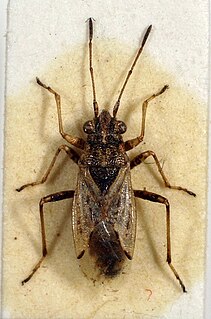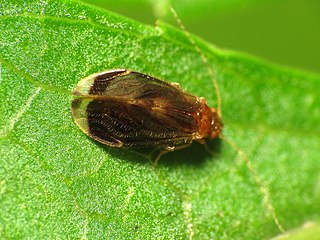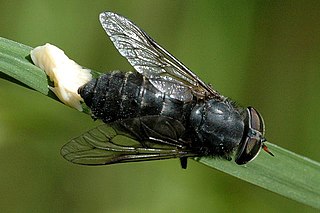
The Integrated Taxonomic Information System (ITIS) is an American partnership of federal agencies designed to provide consistent and reliable information on the taxonomy of biological species. ITIS was originally formed in 1996 as an interagency group within the US federal government, involving several US federal agencies, and has now become an international body, with Canadian and Mexican government agencies participating. The database draws from a large community of taxonomic experts. Primary content staff are housed at the Smithsonian National Museum of Natural History and IT services are provided by a US Geological Survey facility in Denver. The primary focus of ITIS is North American species, but many biological groups exist worldwide and ITIS collaborates with other agencies to increase its global coverage.

Nysius is a genus of false chinch bugs in the family Lygaeidae. There are at least 100 described species in Nysius.

Pallopteridae is a family of flies. The various species are collectively called flutter-wing flies, trembling-wing, or waving-wing flies, because of the striking vibration of the wings in many species. Over 70 species in about 15 genera are found in the temperate regions of the Northern and Southern Hemispheres.

Pachybrachis is a genus of scriptured leaf beetles in the family Chrysomelidae. There are at least 220 described species in Pachybrachis.

Amphipsocidae is a family of hairy-winged barklice in the order Psocoptera. Most species are 3.0-4.5 mm long and have many setae (hairs) on the veins and margin of the forewing. The main veins of the forewing are usually lined with two rows of setae. Like the other members of the infra-order Caeciliusetae, they have a broad, flat labrum, with well defined edges.

The Encyclopedia of Life (EOL) is a free, online collaborative encyclopedia intended to document all of the 1.9 million living species known to science. It is compiled from existing databases and from contributions by experts and non-experts throughout the world. It aims to build one "infinitely expandable" page for each species, including video, sound, images, graphics, as well as text. In addition, the Encyclopedia incorporates content from the Biodiversity Heritage Library, which digitizes millions of pages of printed literature from the world's major natural history libraries. The project was initially backed by a US$50 million funding commitment, led by the MacArthur Foundation and the Sloan Foundation, who provided US$20 million and US$5 million, respectively. The additional US$25 million came from five cornerstone institutions—the Field Museum, Harvard University, the Marine Biological Laboratory, the Missouri Botanical Garden, and the Smithsonian Institution. The project was initially led by Jim Edwards and the development team by David Patterson. Today, participating institutions and individual donors continue to support EOL through financial contributions.

Hybomitra is a genus of horse flies in the family Tabanidae. There are at least 240 described species in Hybomitra.

Campiglossa is a genus of fruit flies in the family Tephritidae. There are at least 190 described species in Campiglossa.

Cerylonidae are small to tiny, smooth, shiny, hairless beetles, only lightly punctured. There are about 450 species worldwide in 50 or so genera, mostly tropical and subtropical. They are most common under the bark of dead trees, but can also occur in compost and other decaying plant material. Little is known specifically about their biology but they are thought to be either predators that feed on other small animals or fungus eating.

The Mycetophagidae or hairy fungus beetles are a family of beetles in the large suborder Polyphaga. The different species are between 1.0 and 6.5 mm in length. The larvae and adults live in decaying leaf litter, fungi, and under bark. Most species feed on fungi. Worldwide, the 18 genera contain around 200 species.
Lakeline Mall is a super-regional shopping mall located in north Austin, Texas, at the intersection of RR 620 and US 183. Although the mall has a Cedar Park postal code, it is physically within the City of Austin. It has 1,097,799 square feet (101,988.9 m2) of gross leasable area. Construction was initially slated to begin in the 1980s but was stalled due to the savings and loan crisis and later stalled due to the discovery of two endangered species on the proposed site.

iNaturalist is a citizen science project and online social network of naturalists, citizen scientists, and biologists built on the concept of mapping and sharing observations of biodiversity across the globe. iNaturalist may be accessed via its website or from its mobile applications. Observations recorded with iNaturalist provide valuable open data to scientific research projects, conservation agencies, other organizations, and the public. The project has been called "a standard-bearer for natural history mobile applications."

Margarinotus is a genus of clown beetles in the family Histeridae. There are at least 110 described species in Margarinotus.
Cultellunguis is a genus of soldier beetles in the family Cantharidae. There are about nine described species in Cultellunguis.

Argia tibialis, the blue-tipped dancer, is a species of narrow-winged damselfly in the family Coenagrionidae. It is found in Central America and North America.
Brachycentrus americanus is a species of humpless casemaker caddisfly in the family Brachycentridae. It is found in North America. It is most prolific in the West and Midwest of North America in July and August.
Urozelotes rusticus is a species of ground spider found in both Americas, Africa, Europe, Asia, Australia. Its native area is unknown, but it is most likely Old World.
Mericisca perpictaria is a species of moth in the family Geometridae first described by William Barnes and James Halliday McDunnough in 1916. It is found in North America.
Gonodonta incurva is a species of fruit-piercing moth in the family Erebidae. It is found in North America.














